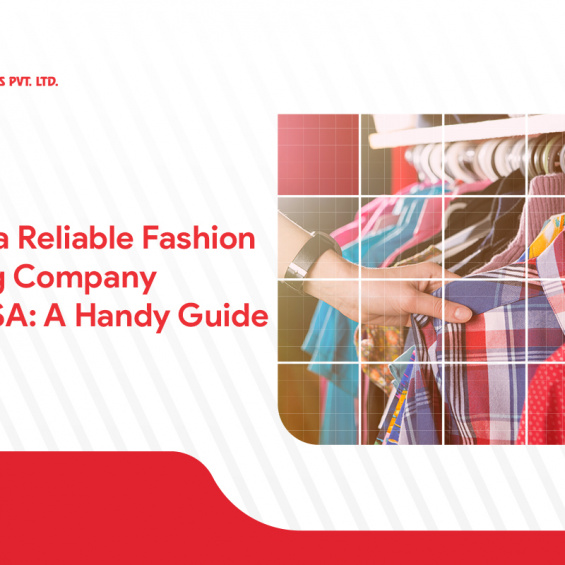Sustainability in Fashion: How Brands are Changing the Clothing Supply Chain?
Fashion sustainability has emerged as both an ethical responsibility and a market-driven requirement. The clothing supply chain is critical to this change and impacts sourcing, manufacturing, and distribution.
By implementing sustainable practices, the fashion industry can minimize its ecological impact, eliminate waste, and promote ethical labour standards, opening the way for a more responsible and long-lasting future.
In this blog, we will examine the functioning, essential components, and how brands are evolving the clothing supply chain.
Understanding the Clothing Supply Chain
The clothing supply chain refers to the web of commerce and services transporting garments and accessories from innovation to supply. Manufacturers, distributors, retailers, and third-party shipping providers are all part of the fashion supply chain.
An excellent clothing supply chain features where everyone includes open lines of communication. Communication is necessary for shortening lead times, improving quality, and ensuring customers and retailers receive timely deliveries. A strong fashion supply chain reduces manufacturing, inventory, and shipping costs while boosting customer satisfaction.
The apparel industry relies on the supply chain to ensure that brands and retailers can make and distribute the proper clothing at the appropriate time to fulfill ever-changing client needs in a competitive marketplace. Moreover, it results in faster turnarounds, lower costs, and a better customer experience, allowing fashion manufacturers and retailers to maximize revenues.
Functioning of Clothing Supply Chain
A fashion designer’s creation of designs is the first step in the supply chain. These designers move to a fabric sourcing firm or a manufacturing plant that converts textiles into garments. After being made, testing clothing for quality check takes place.
If the clothing test is clear, it passes on to online distributors and shipping warehouses or straight to retail stores, where buyers can gain efficient information and resources inside this complicated network, which propels the fashion industry ahead.
Critical Components of the Clothing Supply Chain
The fashion industry can lower its environmental and social imprint by addressing each step with a focus on sustainability, supporting positive change across the fashion supply chain.
1. Materials for Production Sourcing
This step entails acquiring materials such as cotton, wool, and silk. Global sourcing is possible, and it frequently incorporates sustainability, ethical production, and the environmental impact of cultivation or extraction.
2. Manufacturing
The procedures of conveying raw materials into the final product include cutting, stitching, dyeing, and finishing. It is critical to verify that production practices follow ethical labor standards and environmental rules.
3. Distribution and Shipping
The finished goods must be delivered from production facilities to distribution centres and finally to retail outlets. Supply chain shipping, warehousing, and transportation are all parts of this stage, where efficient distribution and shipping can help to decrease emissions and waste.
4. Retail
Retail encompasses both on-site businesses and online shopping platforms. During this stage, brands and retailers can introduce customers to sustainable options, encourage responsible consumption, and manage their environmental impact through energy-efficient operations and waste reduction efforts.
Steps Involve in Fashion Supply Chain
While some retailers prioritize ethical sourcing and environmental considerations, the usual fashion supply chain comprises the following essential stages:
1. Obtaining Raw Materials
The process of acquiring essential raw materials for product manufacturing involves options such as direct procurement from cotton and silk manufactured or third-party suppliers. The primary goal is to acquire high-quality resources at the lowest possible cost while considering fair labour and environmental practices.
2. Production and Design Planning
Designers create a manufacturing plan depending on customer and product requirements at this stage. This stage considers material accessibility, inventory handling, affordability, and product quality.
3. Production and Assembly
This stage converts raw materials into final goods and distributes them to traders. Manufacturers should balance sustaining customer demand and avoiding overproduction, which results in excess, unsold inventory.
4. Distribution
The stage of distribution involves delivering manufacturing goods to retail outlets via wholesalers or to end users. This process frequently entails packing and utilizing multiple transit networks, such as highways, trains, rivers, and airways.
5. Warehousing and Storage
Enterprise intentionally keeps merchandise near the place of sale to ensure speedy and efficient delivery. Storage ensures order completion at the earliest convenience, avoiding hold-offs or stockouts, which drive customers to rivals, whether shopping online or on-site.
6. Optimization of Shipping and Supply Chain
Prioritizing continual improvement is essential to create a more practical approach to optimizing the fashion supply chain, focusing significantly on lower cost and efficiency enhancement. There are multiple strategies to achieve, such as purchasing from affordable suppliers and establishing on time inventory management system.
7. Delivery and Customer Service
The last stage is direct involvement with customers to resolve their delivery, product, and other complaints. The purpose is to ensure customer pleasure, aid with refunds, and provide high-quality service.
Also Read : Key Strategies And Trends Of Apparel Sourcing
7 Advantages of Supply Chain Management
Supply chain management is a comprehensive method that collects and analyzes data at each process level to ensure continuous development. This proactive strategy benefits the fashion industry in various ways.
1. Improved Transparency and Access
Clothing supply chain management improves transparency and access across the supply chain. It allows for real-time tracking of products and supplies, assisting businesses in identifying possible challenges. Supply chain managers enable informed decisions to optimize functions using this knowledge.
2. Boost Efficiency
Effective supply chain management results in shorter lead times, faster responsiveness to market changes, and better resource usage. This greater efficiency leads to cost savings and better resource use, eventually increasing profitability.
3. Cost Reduction
Clothing supply chain management helps to reduce operational costs by optimizing operations and avoiding inefficiencies. This includes lower labor costs, inventory carrying costs, and transportation charges, contributing to higher profitability.
4. Faster Time to Market
Fashion trends change quickly, bringing products to market swiftly gives you compositive advantages. Efficient supply chain management shortens product development cycles and reduces the time it takes for a design to reach customers.
5. Enhanced Collaboration
Effective supply chain management encourages collaboration among various stakeholders, such as suppliers, manufacturers, retailers, and distributors. This collaboration results in improved communication objective alignment and a smoother flow of supplies across the supply chain.
6. Improved Risk Management
Supply chain disruptions can have severe financial and reputational consequences. Due to natural disasters, political conflicts, or economic changes, managing the supply chain enables firms to detect and reduce risks efficiently.
7. Customer Satisfaction
Maintain customer loyalty and the business’s reputation through a well-organized supply chain to ensure that products are available when and when customers want them.
6 Effective Techniques for the Fashion Supply Chain
Fashion brands can stay competitive by implementing effective supply chain techniques from manufacturing to marketing.
1. Invest in Innovative Technologies
When supply chain systems combine scheduling, purchasing, placing orders, billing, transactions, and returns, data can freely flow from one platform to the next, offering industry stakeholders visibility into each stage from one overview.
This type of connection also assists fashion brands in automating their supply chain procedures, increasing efficiency, lowering prices, and restricting mistakes.
2. Follow All Local Regulations
It is vital to update critical rules and regulations that control business operations in various countries. International shipping requires insurance, customs, and taxes. These calculate expenses by a global trading management system based on trade route and transaction type.
This can also keep fashion brands updated on the most recent information, assisting them in complying with local regulations, penalties, and constraints.
3. Enhance Inventory Management
Clothing supply chains strive to keep enough inventory to meet consumer demands. Inventory management solutions give a fashion brand’s warehouse and retail store complete visibility in the fashion world, where trends shift frequently.
This approach can help brands with inventory management by allowing them to achieve a balance between supply and demand. It ensures timely material tracking and sends alerts when stock levels are low, ultimately leading to waste reduction.
4. Regulatory and Anticipatory Analytics
Regulatory and anticipatory analytics allows fashion brands to correctly estimate market demand by analysing recorded data and external factors such as weather and rival strategy.
These analytics provide valuable support to brands by helping them plan orders more effectively, reducing instances of overproduction and stockouts, and ensuring they meet customer demand accurately.
5. Adopt Environmental Sustainability Strategies
Customer awareness of climate change, pollution, and water is increasing, necessitating a transition toward sustainability. Brand should look for eco-friendly materials, take measures to reduce waste and carbon emissions, and incorporate environmentally conscious practices across its supply chain.
As customers demand verification of sustainable activities, displaying these initiatives on websites, packaging, and shop labels is becoming increasingly important.
Also Read : How Can Clothing Production Guarantee Quality Assurance?
Transforming Fashion’s Sustainability: Brands Leading the Evolution of Clothing Supply Chain
For the fashion industry, turning the clothing supply chain into a sustainable one is a vital undertaking. Brands are making considerable efforts to reduce its environmental effects, increase transparency, and adhere to ethical standards. This approach benefits the environment and correlates with the growing customer demand for ethical fashion.
Fashion brands are paving the way for a more sustainable, socially conscious future for the industry by focusing on eco-friendly sourcing, efficient manufacturing, and sustainable shipping.
Take the subsequent step in creating a more sustainable future by analyzing the clothing supply chain. Contact Sararogi Super Sales to promote ethical fashion by developing a more ethical fashion brand.
Frequently Asked Questions:
What is sustainability in clothing industry?
What is the effects of sustainability on supply chains in the apparel industry?
How does sustainability improve supply chain?
How do fashion brands promote sustainability?
What are 5 example of sustainability?
Specializing in sourcing and exporting
a wide range of garments and apparel







